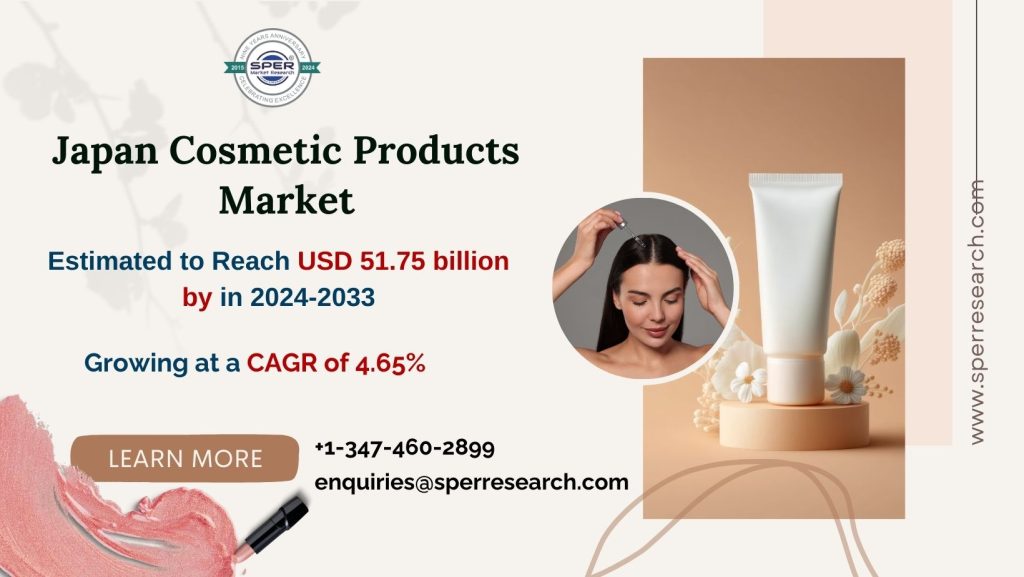Japan Personal Care Products Market to Achieve USD 51.75 Billion by 2033, Registering a 4.65% CAGR Growth-SPER Market Research

Cosmetic items are materials or mixtures supposed to be applied to the body, particularly to the skin, hair, and nails, in order to improve appearance, change odor, cleanse, or beautify. These include cosmetics like lipstick, foundation, and eyeshadow; hair care products like shampoos, conditioners, and styling gels; personal hygiene goods like deodorants and scents; and skincare products like cleansers, lotions, and creams. In order to guarantee product consistency, duration, and appeal, cosmetics are typically made with a blend of inactive components, such as stabilizers, preservatives, and scents, and active substances, which offer certain benefits (such as moisturizers in skincare). These formulations are designed to be safe for external use and are required to meet safety regulations in the majority of nations.
According to SPER Market Research, ‘Japan Cosmetic Products Market Size- By Product Type, By Distribution Channel, By Category- Regional Outlook, Competitive Strategies and Segment Forecast to 2033’ states that the Japan Cosmetic Products Market is estimated to reach USD 51.75 billion by 2033 with a CAGR of 4.65%.
The market for cosmetic items in Japan is expanding due to a number of important factors. The aging population of Japan and the popularity of skincare regimens that prioritize youth and skin health are two main factors driving the rising demand for premium skincare and anti-aging products. Effective, scientifically supported skincare products are well-liked by Japanese customers, and this demand drives cosmetic brands’ innovation and product development, especially in the areas of anti-aging, hydration, and skin-brightening goods. This culture generates a consistent demand for a wide variety of cosmetic products, ranging from skincare and cosmetics to haircare and personal hygiene items. Furthermore, K-beauty and Western beauty trends have broadened the Japanese market’s appeal. The Japanese market is increasingly drawn to natural and organic components.
Request For Free Sample Report @ https://www.sperresearch.com/report-store/japan-cosmetic-products-market.aspx?sample=1
The Japanese cosmetic products market confronts a number of hurdles that could impede its growth trajectory. One key obstacle is the country’s aging population, which, while increasing demand for anti-aging goods, is reducing the total base of youthful, trend-driven consumers. This demographic shift restricts the market for bold, experimental cosmetics popular among younger audiences, reducing the target demographic for specific product categories. Another problem is the fierce rivalry from both local and international brands. While Japanese consumers are extremely loyal to indigenous brands, the entry of global players, particularly Korean and Western brands, has increased rivalry. Foreign firms frequently introduce revolutionary products at low costs, appealing to younger individuals willing to try international beauty trends. Furthermore, Japan’s stringent regulatory framework on cosmetic additives.
The COVID-19 pandemic had a significant impact on the Japanese cosmetic products business, causing adjustments in consumer behavior and product demand. With lengthier lockdowns and the rise of remote work, demand for color cosmetics like lipstick and foundation fell as people reduced their social outings and daily beauty regimens. However, this shift was largely offset by increasing interest in skincare goods, as consumers concentrated on self-care and improving skin health throughout the epidemic. The epidemic also drove the move toward e-commerce, since physical retail channels saw temporary closures and decreased foot traffic. Japanese cosmetic firms, which were traditionally reliant on in-store sales, have changed by increasing their digital presence, improving online purchasing experiences, and providing virtual try-on features.
Tokyo dominates the Japan cosmetic products market due to its high concentration of beauty-conscious consumers and numerous flagship stores of both domestic and international brands. Some of the key market players are A.S. Watson Group, Kao Corporation, Lion Corporation, L’Oréal S.A, Mandom Corporation.
For More Information, refer to below link:-
Japan Cosmetic Products Market Analysis
Related Reports:
Follow Us –
LinkedIn | Instagram | Facebook | Twitter
Contact Us:
Sara Lopes, Business Consultant – USA
SPER Market Research
+1–347–460–2899








